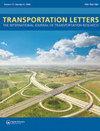利用新型 GTWR 模型探索建筑环境对交通拥堵时空演变的影响:中国合肥案例研究
IF 3.3
3区 工程技术
Q2 TRANSPORTATION
Transportation Letters-The International Journal of Transportation Research
Pub Date : 2025-05-28
DOI:10.1080/19427867.2024.2396773
引用次数: 0
摘要
了解建筑环境对交通拥堵的影响可以为缓解交通拥堵提供可靠的参考。以往的研究对交通拥堵的演变进行了探讨。本文章由计算机程序翻译,如有差异,请以英文原文为准。
Exploring the effect of built environment on spatiotemporal evolution of traffic congestion using a novel GTWR model: a case study of Hefei, China
Understanding the impact of the built environment on traffic congestion can provide reliable references for alleviating traffic congestion. Previous research has explored traffic congestion evolution but often overlooks two key aspects: the frequency of congestion state updates and the spatial-temporal impact of built environment features. Based on data from Hefei, China, we propose a novel geographically and temporally weighted regression (GTWR) model that integrates temporal variables and spatial grids into the traditional GWR model. The empirical results show that public facilities most significantly impact congestion during morning peak hours, scenic spots during afternoon peaks, and motorcycle services in the evening. The study also reveals the rules for the spatiotemporal impact of the built environment on traffic congestion. Finally, the comparison of models shows that the GTWR model outperforms the OLS and GWR models. The findings can guide traffic managers in creating targeted strategies to enhance transportation system efficiency.
求助全文
通过发布文献求助,成功后即可免费获取论文全文。
去求助
来源期刊

Transportation Letters-The International Journal of Transportation Research
TRANSPORTATION SCIENCE & TECHNOLOGY-
CiteScore
6.40
自引率
14.30%
发文量
79
审稿时长
>12 weeks
期刊介绍:
Transportation Letters: The International Journal of Transportation Research is a quarterly journal that publishes high-quality peer-reviewed and mini-review papers as well as technical notes and book reviews on the state-of-the-art in transportation research.
The focus of Transportation Letters is on analytical and empirical findings, methodological papers, and theoretical and conceptual insights across all areas of research. Review resource papers that merge descriptions of the state-of-the-art with innovative and new methodological, theoretical, and conceptual insights spanning all areas of transportation research are invited and of particular interest.
 求助内容:
求助内容: 应助结果提醒方式:
应助结果提醒方式:


